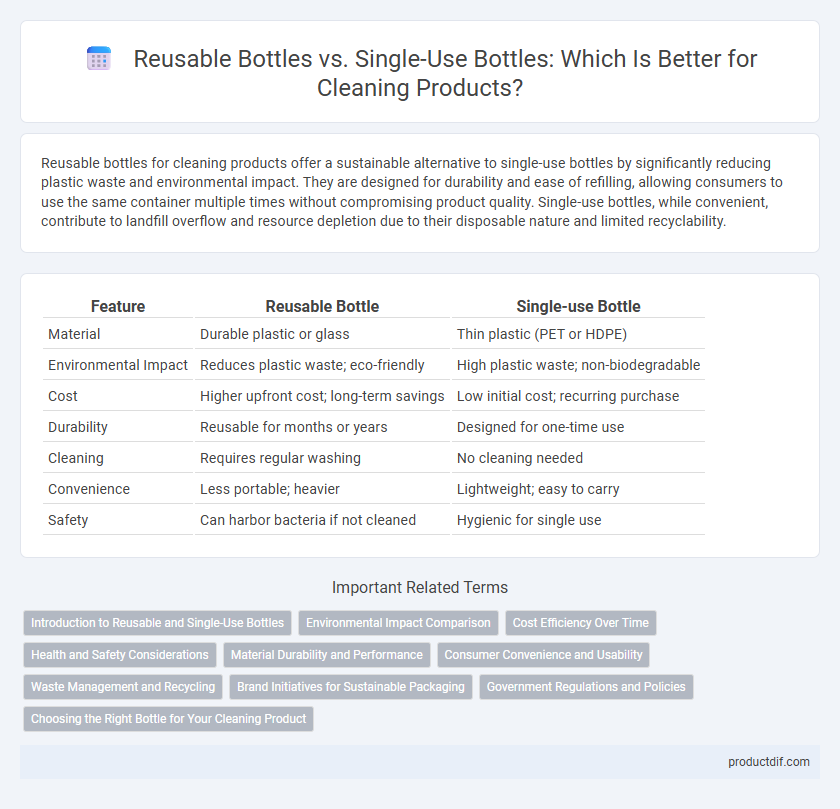Reusable bottles for cleaning products offer a sustainable alternative to single-use bottles by significantly reducing plastic waste and environmental impact. They are designed for durability and ease of refilling, allowing consumers to use the same container multiple times without compromising product quality. Single-use bottles, while convenient, contribute to landfill overflow and resource depletion due to their disposable nature and limited recyclability.
Table of Comparison
| Feature | Reusable Bottle | Single-use Bottle |
|---|---|---|
| Material | Durable plastic or glass | Thin plastic (PET or HDPE) |
| Environmental Impact | Reduces plastic waste; eco-friendly | High plastic waste; non-biodegradable |
| Cost | Higher upfront cost; long-term savings | Low initial cost; recurring purchase |
| Durability | Reusable for months or years | Designed for one-time use |
| Cleaning | Requires regular washing | No cleaning needed |
| Convenience | Less portable; heavier | Lightweight; easy to carry |
| Safety | Can harbor bacteria if not cleaned | Hygienic for single use |
Introduction to Reusable and Single-Use Bottles
Reusable bottles are designed for multiple uses, typically made from durable materials such as stainless steel, glass, or BPA-free plastic, reducing environmental waste and long-term costs. Single-use bottles, often crafted from lightweight plastic like PET, are intended for one-time use and contribute significantly to landfill accumulation and ocean pollution. Choosing reusable over single-use bottles supports sustainability by minimizing plastic consumption and carbon footprint associated with manufacturing and disposal.
Environmental Impact Comparison
Reusable bottles significantly reduce plastic waste and lower carbon emissions compared to single-use bottles, which contribute heavily to landfill overflow and ocean pollution. The production and disposal of single-use bottles consume more energy and resources, increasing their overall environmental footprint. Choosing reusable bottles supports sustainable water consumption practices and helps mitigate the global plastic crisis.
Cost Efficiency Over Time
Reusable bottles demonstrate superior cost efficiency over time compared to single-use bottles by significantly reducing the need for frequent purchases. Initial investment in durable reusable bottles leads to long-term savings due to their extended lifespan and resistance to wear. Single-use bottles, while cheaper upfront, accumulate higher expenses through continuous replacement and contribute to greater environmental waste.
Health and Safety Considerations
Reusable bottles reduce exposure to harmful chemicals commonly found in single-use plastic bottles, such as BPA and phthalates, enhancing overall health safety. Proper cleaning and maintenance of reusable bottles prevent bacterial growth and contamination, ensuring safe usage over time. Single-use bottles, often made from lower-grade plastics, pose potential health risks through chemical leaching, especially when exposed to heat or sunlight.
Material Durability and Performance
Reusable bottles are typically made from high-quality materials such as stainless steel, glass, or BPA-free plastics, which ensure enhanced durability and resistance to wear and tear compared to single-use bottles. These materials maintain the integrity of cleaning products without degrading or leaching harmful substances over multiple uses. Single-use bottles, often made from thinner plastics like PET, are prone to cracking and chemical breakdown, compromising both performance and environmental sustainability.
Consumer Convenience and Usability
Reusable bottles offer greater consumer convenience through durability and long-term usability, reducing the need for frequent repurchasing compared to single-use bottles. Their design often includes features like easy-to-clean surfaces and spill-proof lids, enhancing user experience during cleaning product application. Single-use bottles provide immediate convenience with lightweight, pre-measured doses but generate more waste and lack the ergonomic benefits of reusable options.
Waste Management and Recycling
Reusable bottles significantly reduce waste generation compared to single-use bottles by minimizing the frequency of disposal and the demand for raw materials. Effective waste management systems prioritize recycling programs that can process reusable bottles multiple times, enhancing resource efficiency and lowering environmental impact. Single-use bottles often contribute to landfill overflow and pose greater challenges in recycling due to contamination and material degradation.
Brand Initiatives for Sustainable Packaging
Leading cleaning product brands are investing heavily in sustainable packaging by promoting reusable bottles to reduce plastic waste and carbon emissions. Initiatives such as return-and-refill programs and the use of durable, BPA-free materials enhance the lifecycle of reusable bottles while minimizing environmental impact. Consumer demand for eco-friendly solutions drives innovation in recyclable inks, biodegradable labels, and closed-loop systems that support circular economies in packaging design.
Government Regulations and Policies
Government regulations increasingly favor reusable bottles to reduce plastic waste and lower environmental impact, mandating stricter limits on single-use plastic production and disposal. Policies such as extended producer responsibility require manufacturers to manage the lifecycle of single-use bottles, incentivizing the adoption of sustainable alternatives. Compliance with these regulations drives innovation in cleaning product packaging, emphasizing durability, safety, and recyclability of reusable bottles.
Choosing the Right Bottle for Your Cleaning Product
Selecting the right bottle for your cleaning product significantly impacts sustainability and product performance. Reusable bottles reduce plastic waste and offer durability, making them ideal for eco-conscious consumers and concentrated solutions. Single-use bottles, however, provide convenience and are often cost-effective for mass production but contribute to environmental pollution.
Reusable bottle vs Single-use bottle Infographic

 productdif.com
productdif.com